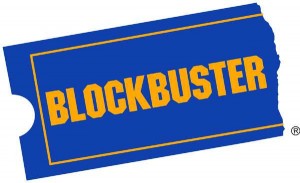don’t stop retailin’, blockbuster
Jonathan Salem Baskin recently posted an “open memo to Blockbuster’s 
Before I do, though, I have to explain that my perspective on Blockbuster (and most any retail business for that matter) is biased — in that I really want to see them succeed. Despite the plummeting sales experienced by so many retailers lately and the forecast of continued doom and gloom in the sector, I am a big fan of retail — and in this case, I’m referring to good old brick and mortar, foot (not click) traffic retailers.
Why? Because, despite doing a large percentage of my shopping online, I’ve found there is nothing like soaking in the sights and sounds of a well-designed, stimulating space, being served by salespeople who really know their stuff and want to help you, and experiencing all the innovative products and services that a great retail brand has to offer (please see my post about best practices of retailers.)
So, while Blockbuster’s Keyes may want to evolve the business from a video-rental chain to a full-service media delivery company, I would recommend he put more focus on reinvigorating Blockbuster as a retail brand.
And Keyes knows how to do this — really well. He signed on to head the movie rental chain after a 21-year stint at
Three moves from his 7-11 turnaround playbook might actually serve Blockbuster quite well:
- 7-11 instituted new retail systems technology to improve product assortment decisions in every store. In the same way, Blockbuster might tailor its product line to sync with local preferences or to suit the shopping environment — and be able to develop different store concepts to match demand. For example, a store in the Mall of America might focus on offering up a broad array of family entertainment while a kiosk on a college campus might feature a more eclectic and limited selection. Doing so would enable Blockbuster to create more impactful customer experiences because they’re more targeted and specialized. That would certainly fulfill Keyes’ vision of “transforming the relevance to the customer by the way we reach out to them in their daily lives.”
- At 7-11 Keyes collaborated with manufacturers to develop new products like new Slurpee flavors, taquitos, and special sandwiches. It’s easy to see how a similar approach with movie studios and content producers could yield custom products like exclusive boxed sets or compilations — thus generating a constant stream of new news that in turn generates regular store traffic.
- 7-11 developed new in-store electronic services like kiosks for cashing payroll and personal checks, purchasing money orders, and paying bills. In Blockbuster’s case, perhaps their services could be:
- self-service stations where people can access and pay for content and load it onto their personal electronic devices in one easy, convenient, super high-speed step
- or Genius Bar or Geek Squad-type services provided by experts who troubleshoot problems and offer consultation
- or even concierge-level services for people who want to simply say the word and have their desired content available wherever/whenever they fancy — there are a lot of people, and not just old ones, who want to access all the great content that’s out there but don’t want to deal with the hassles of electronic media delivery
- or maybe all 3? The point is, despite what seems to be a wholesale migration of content to online, there is still a lot of added-value Blockbuster can deliver in-person through their stores.
So, rather than trying to reinvent their brand, perhaps they should embrace it. As Jonathan states, “There’s no Blockbuster without the geophysical stores and physical merchandise.”
Importantly, this suggestion doesn’t solely come out of my usual advice to brands to “stick to your knitting” (i.e., remember your brand values and attributes and focus on executing the heck out of them) — it also comes from a true belief that there is still a need for a entertainment content retail concept and that Blockbuster is in the best position to fill it.
So, Blockbuster, I say, keep the faith — don’t stop believing in the power of retail.